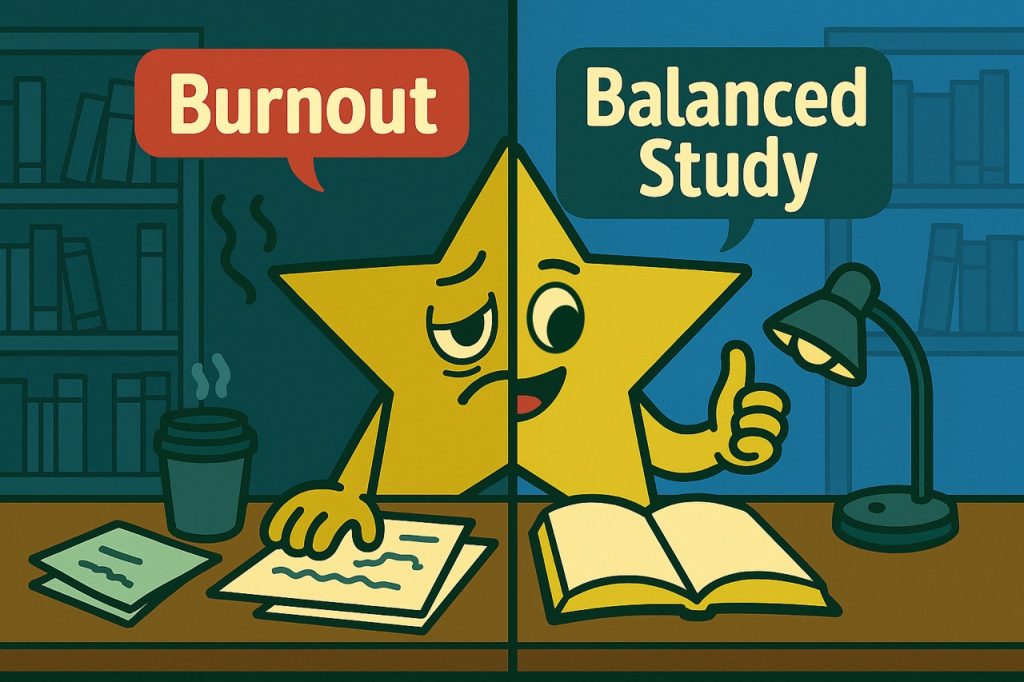
The ultimate guide to building effective study habits
- Study tips
- 6 min read
- September 8, 2025
What study burnout looks like, and why it is rising
Academic burnout is common Recent research in higher education finds that stress and burnout among students are widespread, and in some contexts their prevalence exceeds that of the working population. Burnout is linked to impaired health and increased risk of dropping out, while study engagement is protective. These findings reinforce what many students and tutors see each term: long hours alone do not translate into better outcomes when energy and motivation collapse. Mental health trends offer a mixed picture Large annual surveys suggest that some indicators have improved in the last year, with declines in reported depression and suicidal ideation among college students, alongside increased access to support. Progress is real, yet many students still report significant psychological distress and pressure, so prevention during exam periods remains essential. What burnout feels like day to day- Constant fatigue and trouble concentrating, even after “studying” for hours.
- Irritability or indifference toward coursework you used to enjoy.
- Endless cycles of rereading and highlighting without recall.
- Procrastination, then frantic cramming that does not stick.
- Sleep disturbances that make the next day even harder.
Study less, score more: the science behind efficient learning
Active recall beats passive review Self testing, practice questions, and explaining answers out loud strengthen memory more than rereading. The testing effect is robust across age groups and subjects. Frequent low stakes retrieval makes learning stick without extra hours. Spaced repetition multiplies results Instead of cramming, spread practice across days. A major meta analysis covering hundreds of experiments shows that distributed practice significantly improves retention compared with massed study. Space your sessions, and you can study less total time for higher recall. Low stakes quizzes reduce anxiety, raise performance Formative assessment, especially frequent low stakes quizzes with feedback, is associated with improved learning outcomes in higher education. Students get earlier signals about what to fix, which reduces panic before high stakes exams. Lecturers also get insight to target support. Time management is a skills multiplier Meta analytic evidence links concrete time management behaviors like planning and prioritization with better grades and engagement. Clear weekly plans reduce decision fatigue, free up attention for actual learning, and buffer stress. Sleep is not a luxury, it is a study strategy While effect sizes vary across studies, the direction is consistent: better sleep supports learning, attention, and mood. Treat sleep like a scheduled lab: fixed start time, fixed end time, and no last minute cancellations. Your next day’s study quality depends on it.Practical study hacks that protect your energy
1: Build a weekly “exam rhythm” instead of daily marathons- Pick four focused study blocks of 50 to 60 minutes per day, five days per week.
- Assign each block to one course or one topic cluster to avoid context switching.
- End every block with a 5 minute wrap up: write a one sentence summary and list one confusion to revisit.
- Start with a quick brain dump of everything you remember about a topic, then check gaps.
- Move to short answer prompts, then mixed practice questions that force discrimination.
- Finish with a “teach back” to a friend or to your phone recorder. Explaining exposes illusions of knowing.
- Rotate topics across days to let forgetting begin slightly before you restudy, which strengthens memory when you retrieve again.
- Interleave similar problem types, for example different derivative rules or different case analyses, so you practice choosing methods, not just executing them.
- Create or source two to five low stakes questions for each lecture as soon as you finish it.
- Schedule a weekly “quiz hour” to cycle through missed items, then tag anything you still cannot retrieve for next week.
- Plan no more than 70 percent of your waking hours. Leave room for delays, meals, and recovery.
- Batch admin tasks like emails, calendar updates, and forms into one short block to protect deep work. Evidence connects structured time use with higher engagement and performance.
- Fixed bedtime and wake time, even on weekends.
- Cut off caffeine 8 hours before bed, and screens 60 minutes before bed. Reviews link insomnia symptoms and stress, so your sleep routine is part of your study plan.
- Short walks, light exercise, and friend check ins are active recovery that stabilizes mood and sharpens attention for your next block.
- Label emotions briefly on paper: “anxious about topic X,” then choose one action. Naming reduces rumination.
Save hours with AI, without sacrificing judgment
AI can reduce study time when used for process, not replacement Early studies and institutional pilots suggest that AI assistants can cut the time students spend on routine study tasks. For example, one university reported a 27 percent average reduction in study time among distance learners using an AI learning assistant, primarily by automating summaries and practice question generation. Treat these tools as accelerators for the parts of studying that do not require your unique reasoning. Emerging academic work points in the same direction: students report time savings and in some cases improved grades when AI is used to scaffold learning and personalize practice. The benefits come with caveats: over reliance can backfire, and integration with existing habits matters. Use AI to draft, not to decide, and always verify. Practical AI workflows that respect student mental health- Lecture to outline in minutes: paste lecture notes into an AI and ask for a concise outline with key concepts, definitions, and 5 comprehension questions. Review, correct, and then study from your version.
- Auto generate active recall prompts: convert sections of your notes into short answer questions, then export them to a quiz deck. Retrieval beats rereading, and AI speeds the setup.
- Versioned notes for less chaos: keep a running changelog for each topic so you can roll back to the last clean state, compare versions, and share stable snapshots for group study without fear of overwrite.
- Smart scheduling: ask AI to translate your syllabus into a spaced study plan with topic rotations and weekly quiz sessions. Cross check against your calendar before you commit.
- Always verify technical steps, formulas, and citations by checking your textbook or trusted sources.
- Use AI to simplify wording, not to invent content for graded work without permission.
- Keep a “why I agree” note for every AI suggestion you adopt. If you cannot explain it, do not include it.
What lecturers wish you knew about learning
Frequent, low stakes practice is built to reduce anxiety Reviews of formative assessment in higher education conclude that low stakes quizzing and timely feedback tend to improve learning when implemented thoughtfully. This approach helps you catch misconceptions early and steadily build mastery, which lowers exam stress. It also gives lecturers signals to adjust teaching before the final. Office hours are undervalued, and they compound Studies and institutional reports consistently note that office hours are underused, yet design choices like timing, format, and communication can increase attendance and perceived value. A short visit to check your understanding early can save multiple frustrated hours later. Treat office hours as part of your weekly system, not a last resort. When you come prepared, feedback goes further Lecturers are most effective when you bring a specific question, a failed attempt, or a one page summary of what you understand and where you got stuck. This turns office hours into targeted study sessions with strong returns. Pilot work and teaching center guidance point to measurable benefits when office hours function this way.A 7 day reset to cut hours and recover focus
Day 1: Audit and subtract- List all topics and deadlines. Circle the 20 percent that drive 80 percent of your grade.
- Identify two low value commitments to pause for two weeks. Protect your bandwidth.
- Map four daily study blocks across five days. Assign topics to each block. Add a nightly quiz slot.
- Set bedtime and wake time alarms. Treat sleep like a lab to stabilize mood and memory.
- For each lecture, generate 5 to 10 short answer questions. Use AI to draft, then you edit for accuracy.
- Create a deck for each course and schedule spaced review across the week.
- Mix practice across similar topics. Force yourself to choose the right method, not just apply one you just saw.
- End with a 20 minute low stakes quiz and immediate feedback. Track mistakes and tag for tomorrow.
- Bring one page: what you know, what you tried, where you got stuck. Ask for the smallest next step.
- Book your next check in before you leave to maintain momentum.
- Run a timed practice. No notes, no phone. Grade yourself using the mark scheme where possible.
- Write a short reflection: one concept to relearn, one careless error to prevent, one strategy that worked.
- Take a half day off from study. Move your body, see a friend, and sleep.
- Preview next week’s plan for 15 minutes. Small glimpses reduce anticipatory stress.
Where an all in one AI native study workspace fits
If you want one place to tie this together, modern study apps can help. For example, Blekota gives you an all in one AI native study workspace with an AI chat and agent that can help you understand material or create study materials like flashcards, practice tests, notes, and oral exam scripts. You can turn lectures into question banks for active recall, version control your notes to avoid chaos during group work, and auto build spaced review plans that support student mental health during peak stress. There is a free week trial, so you can try it without risk and keep what helps. Use it as one option among many, and always keep your judgment on top.Common pitfalls to avoid when cutting study hours
Replacing thinking with tools AI can summarize and generate prompts quickly, but it cannot do your learning. Always retrieve from memory before you read an answer. If you are not effortfully recalling, you are not training the skill that the exam measures. Swapping quantity for chaos Reducing hours without structure increases stress. Keep a simple plan: four focused blocks per day, weekly quiz sessions, and nightly shutdown. Time management behaviors correlate with better academic outcomes because they reduce noise. Ignoring sleep and basic needs When sleep collapses, everything else gets harder. Build your schedule around sleep first, then study. Protecting sleep is both a mental health decision and an academic one.Expert and lecturer aligned checklist
- Use active recall and spaced repetition across the whole term.
- Prefer frequent, low stakes practice with feedback over rare, high stakes cramming.
- Plan your week, not just your day. Batch admin tasks and protect recovery time. }
- Use office hours early, with specific questions and attempts.
- Let AI automate busywork like summarizing and question generation, then verify and edit.
Conclusion: less time, more learning, better wellbeing
Studying less and scoring more is not a paradox when you switch from hours based studying to learning based studying. Active recall, spacing, and low stakes quizzes are the backbone. Simple time blocking protects your attention, sleep stabilizes your memory, and AI clears the busywork. Together these choices reduce study burnout and support student mental health without sacrificing results. If you want a single workspace to put this plan on rails, explore tools like Blekota. It is an all in one AI native study workspace with chat and agent features that help you turn lectures into practice and keep your notes version controlled, and you can try it free for a week. Keep using what measurably reduces your stress and raises your recall. Your grades and your wellbeing can improve together.Study habits are the backbone of academic success. Yet many students still rely on last-minute cramming, all-nighters, and endless highlighting that rarely lead to true understanding. Developing effective study habits is not just about working harder, but about working smarter. The right approach can save you hours each week, reduce stress, and improve your confidence when exams arrive.
This guide dives deep into how to build study habits that last. We will cover how to organize your study materials efficiently, how to use flashcards and active recall for memory retention, and how to leverage e-learning apps and digital workspaces to stay productive. By the end, you will have a complete system that you can tailor to your needs, whether you are a university student, a lecturer, or a lifelong learner.
Why Strong Study Habits Matter
Why should you care about study habits in the first place? Because habits are what carry you through when motivation fades. Relying only on willpower creates burnout and inconsistency. Habits, on the other hand, turn good practices into automatic routines.
Research consistently shows that effective study strategies increase performance. Students who apply active recall and spaced repetition outperform those who simply reread their notes. Those who set up structured environments and routines are less likely to procrastinate. Strong habits also create a positive feedback loop: success breeds confidence, and confidence reduces anxiety during exams.
Key reasons to build study habits:
- Improved memory retention and recall under pressure
- Better management of time and academic workload
- Lower stress and burnout rates
- Higher consistency across semesters, not just during exams
Without intentional habits, even the smartest students risk wasting time on ineffective methods. With them, you can maximize results without sacrificing your health.
Step 1: Organizing Your Study Materials
Organization is the foundation of effective study habits. If your materials are scattered across apps, folders, and physical notebooks, you lose time and focus every time you sit down to study. Centralization is key.
Practical strategies for organizing:
- Create a single hub: a digital folder, cloud workspace, or note-taking app where everything lives.
- Sort by course and topic: use consistent naming conventions such as “Biology_Lecture3_ProteinSynthesis”.
- Keep an “Essentials” folder with syllabi, assignment deadlines, and grading rubrics.
- Digitize handwritten notes or snapshots from the board for easier access later.
- Do a weekly clean-up: archive old drafts and keep only the most updated material in your active folders.
Having all your resources neatly arranged reduces decision fatigue. When you sit down to study, you know exactly where to find what you need. This mental clarity makes it easier to dive into deep work instead of wasting energy searching for materials.
Step 2: Mastering Flashcards and Active Recall
One of the strongest habits you can adopt is the use of flashcards. They remain one of the most researched and effective study tools because they directly engage the brain in active recall. Unlike rereading or highlighting, flashcards force you to retrieve information from memory, which strengthens neural pathways.
How to build effective flashcards:
- Make them concise: one question per card.
- Use your own words: personalization improves recall.
- Include images, graphs, or diagrams when possible.
- Mix types: factual recall (“What year did X happen?”) and application (“How does X impact Y?”).
- Review with spaced repetition: revisit difficult cards more often, let easy ones fade into the background.
Flashcards are especially powerful when combined with spaced repetition systems (SRS). This method ensures you review cards at optimal intervals, maximizing long-term retention while reducing the total number of reviews needed.
If you create them consistently across the semester, your exam revision becomes a matter of review rather than relearning from scratch.
Start studying smarter
Unlock your full academic potential.
Blekota helps you organize notes, create effective flashcards, and prepare for exams with confidence.
Unlock your full academic potential. Blekota helps you organize notes, create effective flashcards, and prepare for exams with confidence.
Step 3: Structuring Your Study Routines
Consistency beats intensity. A short, focused daily study habit is more effective than occasional long cram sessions. The key is to design routines that are realistic and sustainable over time.
Tips for designing your study routine:
- Anchor study sessions to existing habits: for example, review flashcards after breakfast.
- Use the Pomodoro method: 25 minutes focused work, followed by a 5-minute break.
- Set a daily “minimum effective dose”: even 20 minutes counts, as long as it is consistent.
- Track your sessions in a log or calendar to visualize progress.
By embedding study into your daily life, you reduce reliance on last-minute pressure. Over time, your brain adjusts and expects focused work at specific times, making it easier to get started without procrastination.
Step 4: Leveraging Digital Workspaces and E-Learning Apps
Modern students live in a fragmented digital environment: email, LMS, messaging apps, cloud folders, and personal notes. Switching between them drains cognitive energy. That is where unified e-learning apps come in.
Study apps like Blekota allow you to bring everything together: lecture notes, flashcards, study reminders, and practice tests. With AI features, you can even transform course notes into quizzes or generate flashcards automatically. This not only saves time but also ensures that your study routines are grounded in active learning techniques rather than passive review.
How digital workspaces support study habits:
- Centralize all study materials and notes in one place
- Generate flashcards and practice exams automatically
- Track your study sessions and measure consistency
- Collaborate with classmates through shared notes or group study rooms
Technology is not a replacement for habits, but it is a powerful amplifier. When combined with consistent routines, a digital workspace can make it easier to maintain discipline and avoid distractions.
Step 5: Reflection and Iteration
Building study habits is not a one-off task but a process of continuous improvement. What works in one semester may need adjusting in another. Reflecting on your progress ensures that your habits evolve with your needs.
Reflection prompts:
- Which strategies save me the most time?
- Where do I still feel stressed or unprepared?
- Am I relying too much on passive study methods?
- Do I need to adjust my environment or tools?
Every few weeks, take 15 minutes to evaluate your current system. Identify bottlenecks and experiment with small changes. Over time, this habit of reflection ensures your approach becomes more efficient and more tailored to your personal learning style.
Practical Examples: A Week of Smart Habits
To make these ideas concrete, let us imagine how a typical week might look for a student applying these strategies.
Monday: Review flashcards from last week’s lectures in the morning. Spend 1 hour in the afternoon organizing new slides and notes.
Tuesday: Work on assignments for 90 minutes using the Pomodoro technique. Generate new flashcards from the day’s lecture notes.
Wednesday: 20 minutes of active recall practice before class. Short review of key flashcards after dinner.
Thursday: Group study session using shared notes in your digital workspace. Practice answering potential exam questions aloud.
Friday: Consolidate the week’s materials. Archive outdated drafts. Add all new flashcards to your deck.
Weekend: One longer review session covering the hardest flashcards. Reflect on the week and adjust next week’s plan.
This structured yet flexible approach ensures that learning is continuous and manageable rather than stressful and reactive.
Conclusion
Effective study habits are not about cramming more hours but about building smarter systems. Organizing your materials, practicing with flashcards, maintaining consistent routines, and using unified digital workspaces all work together to create a more productive and less stressful learning experience.
With study apps like Blekota, you can centralize your learning, generate active recall exercises automatically, and track your study journey. It is a way to work with your brain rather than against it, making study time more focused and more rewarding. The best part: you can try it free for a week and see how it fits into your routine.
Remember: habits form your academic identity. By investing in them now, you are not just preparing for your next exam, you are building the foundation for a lifetime of learning.




